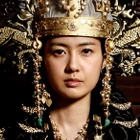
Queen Seon Deok[]
Princess Deokman / Queen Seondeok (actress Lee Yo-won) “The queen is my destiny” After surviving many crises in her life, she finally became the ruler of Silla. Her loyal followers included General Kim Yushin and Kim Chunchu. She became the first female ruler in Korea’s history and laid the foundation for the unification of the three kingdoms under Silla. She was born as the twin sister of Princess Cheonmyong and had a close brush with death as a baby due to the attempted assassination by Lady Mishil, who had ambitions for the throne. A loyal servant named So-hwa rescued her by fleeing the kingdom with her. She was raised outside of the kingdom until she was 15. She then returned to Shilla in hopes of finding her father.
History[]
Selection as Heiress
Before she became queen, Seondeok was known as Princess Deokman (덕만(德曼)). She was the second oldest of King Jinpyeong's three daughters. The son of her sister Princess Cheonmyeong became a king in his own right while Seondeok's sister, Princess Seonhwa eventually married King Mu of Baekje and became mother of Uija[3]. Because he had no sons, Jinpyeong had selected Seondeok as his heir. The act was not unusual within Silla, as women of the period had already had a certain degree of influence as advisors, dowager queens, and regents. Throughout the kingdom, women were heads of families since matrilineal lines of descent existed alongside patrilineal ones. The Confucian model, which placed women in a subordinate position within the family, was not to have a major impact in Korea until the mid Joseon period in the fifteenth century. During the Silla kingdom, the status of women remained relatively high, but they were expected to do their duties and not try to do activities that were considered to be unwomanly.
Reign
In 634, Seondeok became the sole ruler of Silla, and ruled until 647. She was the first of three female rulers of the kingdom (the other two being: Jindeok of Silla and Jinseong of Silla), and was immediately succeeded by her cousin Jindeok, who ruled until 654. Seondeok's reign was a violent one; rebellions and fighting in the neighboring kingdom of Baekje filled her days. Yet, in her fourteen years as queen of Korea, her wit was to her advantage. She kept the kingdom together and extended its ties to China, sending scholars there to learn. Like Tang's Empress Wu Zetian, she was drawn to Buddhism and presided over the completion of Buddhist temples. She built the "Star-Gazing Tower," or Cheomseongdae, considered the first observatory in the Far East. The tower still stands in the old Silla capital of Gyeongju, South Korea.
Legends
It is believed that Seondeok's selection as her father's successor were attributed to displays of perceptive intelligence when she was a princess. One such story (both in Samguk Sagi and Samguk Yusa) entails that her father received a box of peony seeds from the Emperor Taizong of Tang accompanied by a painting of what the flowers looked like. Looking at the picture, unmarried Seondeok remarked that while the flower was pretty it was too bad that it did not smell. "If it did, there would be butterflies and bees around the flower in the painting." Her observation about the peonies' lack of smell proved correct, one illustration among many of her intelligence, and thus ability to rule. There are two other accounts of Seondeok's unusual ability to perceive events before their occurrence. In one account, it is said that Seondeok once heard a horde of white frogs croaking by the Jade Gate pond in the winter. Seondeok interpreted this to indicate an impending attack from the Kingdom of Baekje (the croaking frogs were seen as angry soldiers) to the northwest (derived white symbolizing the west in astronomy) of Silla at the Woman's Valley (interpreted from the Jade Gate, a term related to women). When she sent her generals including Alcheon to the Woman's Valley, they were able to successfully capture two thousand Baekje soldiers. The second account is about her death. Some days before her death, she gathered her officials and bidded, "When I die, bury me near the Dori-cheon(忉利天, "Heaven of Grieved Merits")." Decades after her death, Munmu of Silla, 30th king constructed Sacheonwang-sa(四天王寺 "Temple of the King of the Four Heavens") in her tomb. Then nobles realized that one of the Buddha's saying, "Dori-cheon is above the Sacheonwang-cheon" was accomplished by the Queen.